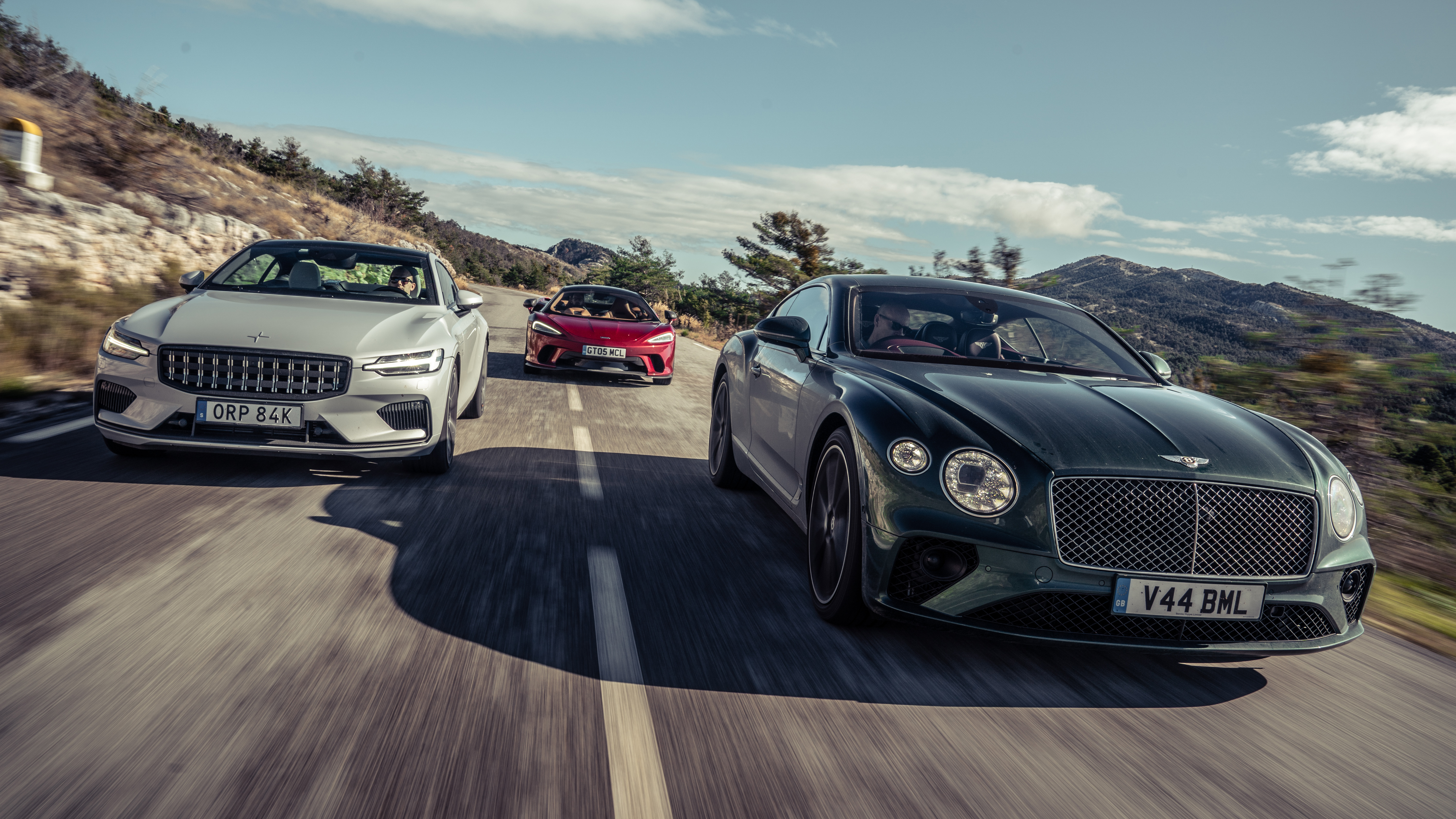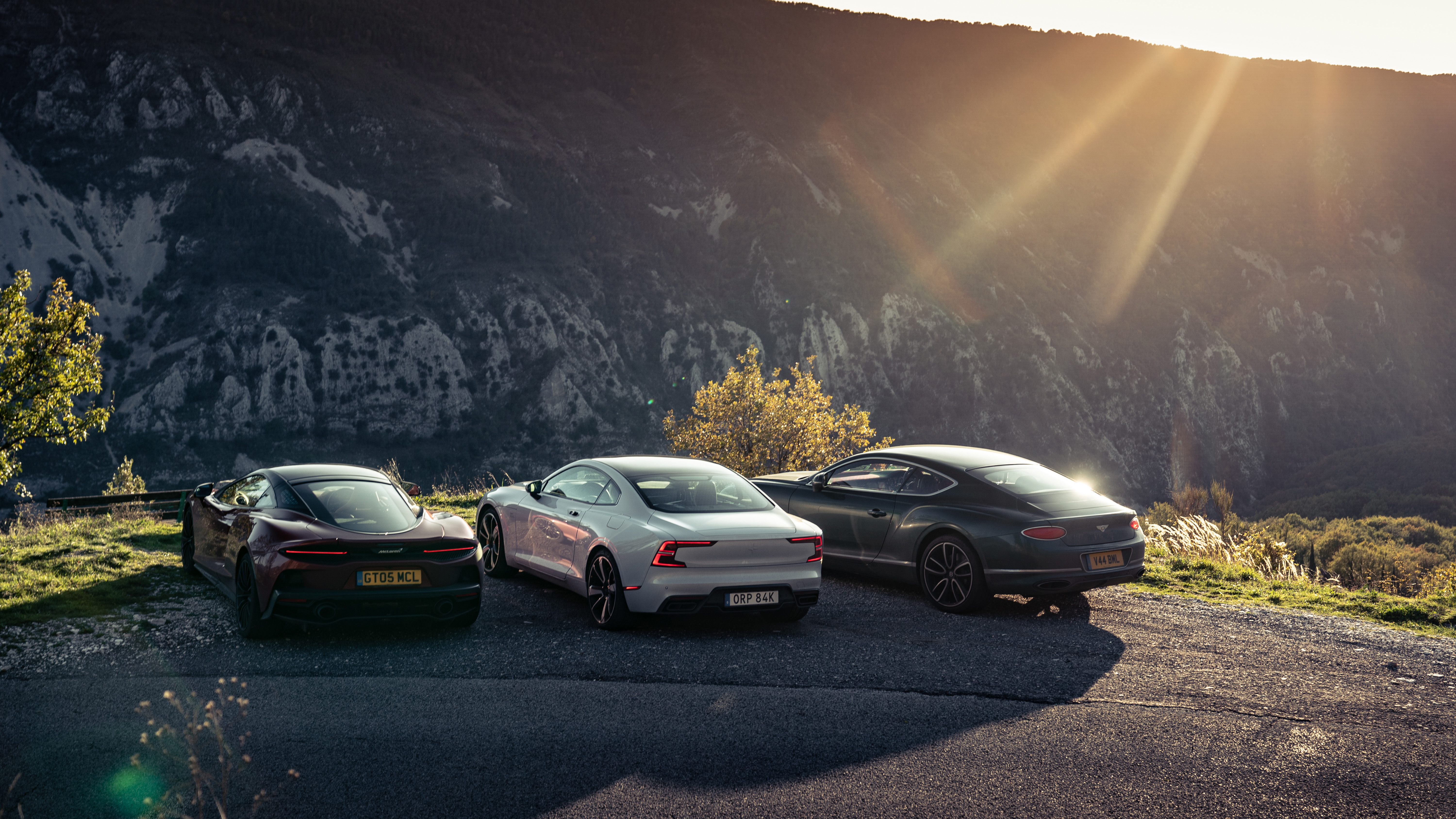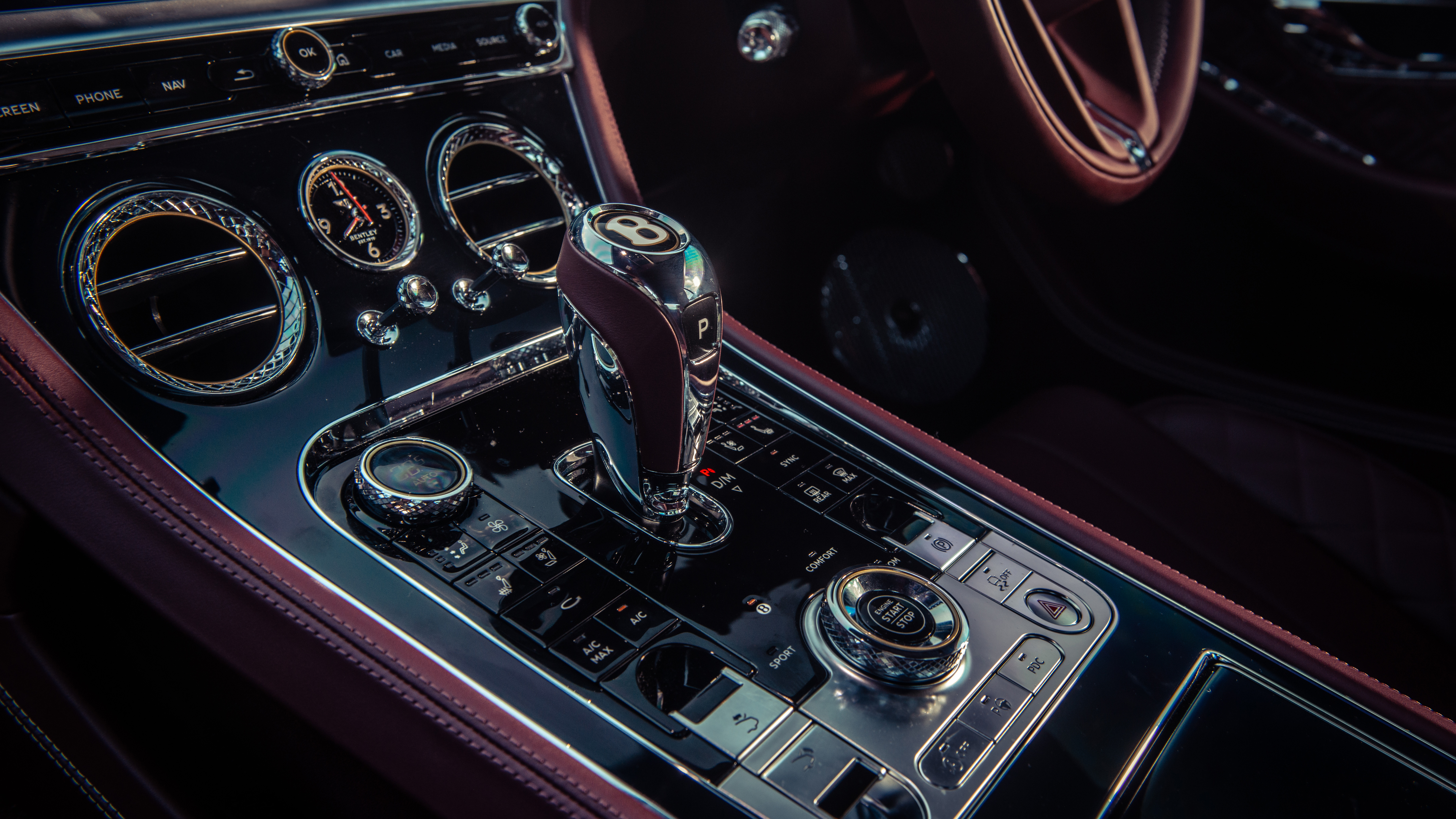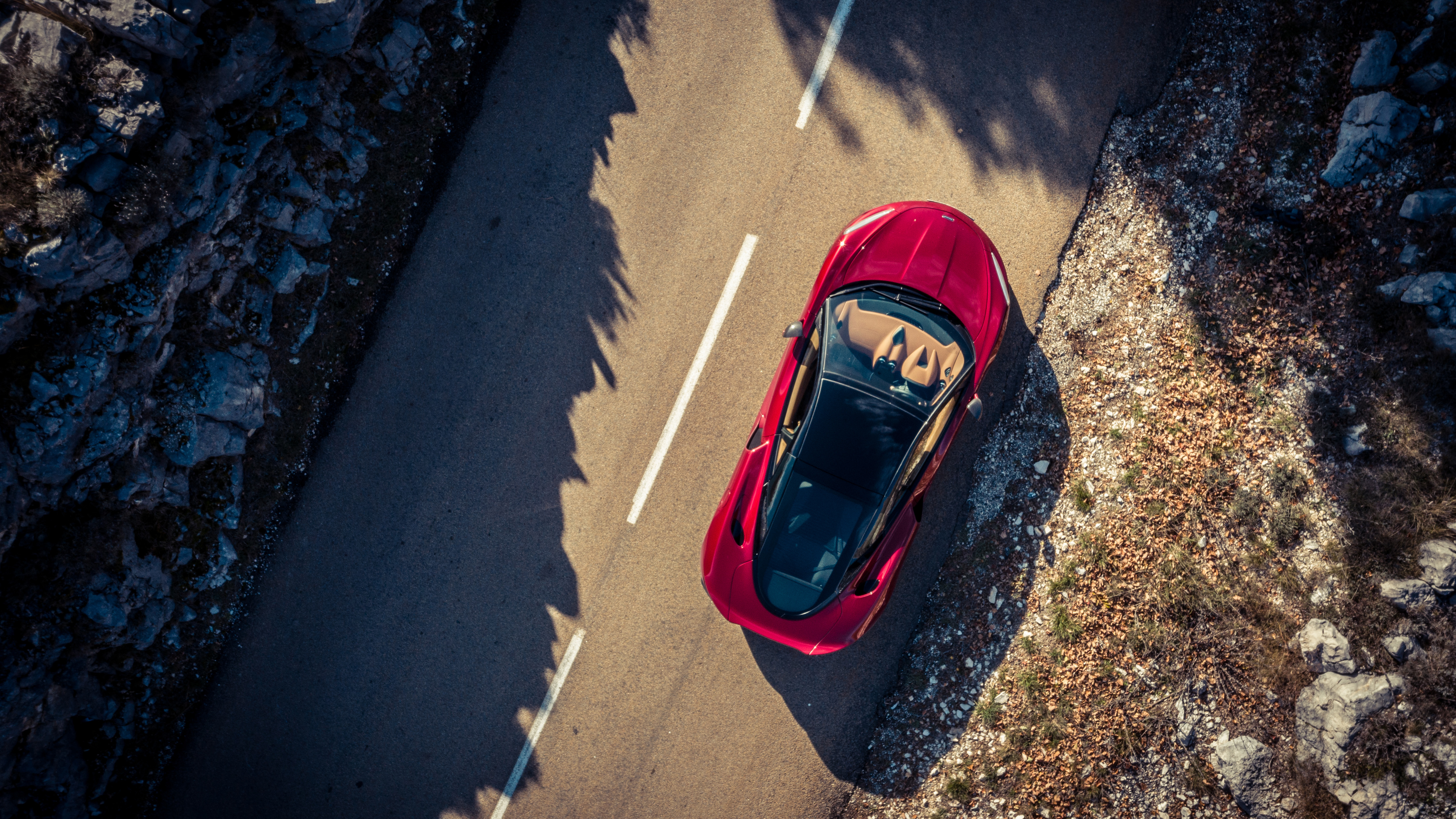
McLaren GT vs Polestar 1 vs Bentley Continental GT
Three different takes on a grand tourer meet in the embers of the day for a blast from Nice to the mountains
The moment a sailing boat rises onto its plane, everything changes. It’s not just about the extra speed, intense though that is. Breaking through its own bow wave, the craft tenses its muscles. It’s more urgent to the tiller and sheets. Instead of moving in simple rhythm with the waves beneath, it skims, dancing, superimposing movements of its own onto your inputs. It’s no longer just you sailing; the craft gains its own animus. This is what happens when you’re on a good road in a fine mid-engined car. And the McLaren GT is one.
Drive the same road in the Continental GT and you’re aboard a displacement yacht. One that has great seakeeping qualities. It eases through the swells and sets its course with reassuring quiet dignity. It’s your long-distance home, and when things get stormy it’s your refuge, whereas on a planing boat, lengthy exposure can be exhausting.
Words: Paul Horrell / Photography: Rowan Horncastle
We could waste an enjoyable evening and several pints arguing about the definition of a GT car. We all know the history: a race-type chassis carrying coachwork that added some style and comfort. In those days, long-distance speed depended on that race engineering. It no longer does, because of enforcement and traffic. So, in our beery argument, I’d assert that the Bentley Continental GT has been for years and remains the definitive grand tourer, because it’s not just powerful but also securely quick in all conditions thanks to its 4WD. Plus its refinement and comfort mean you’re never knackered. It’s ruddy stylish, too, so you feel good arriving in it.
So these have been the rules for ages: supercars are fantastic when you get to the glamorous sunlit mountain passes, but GTs are better for the long haul across the plains.
But now McLaren aims to leap this chasm with the GT, a friendlier, more usable kind of supercar. Question is, how big or small is its deficit versus the Bentley at the day-to-day and long-distance stuff? Is this a deficit you’d gladly suffer in order to experience its supercar joys in the mountains?
To shake things up even more, just as the supercar of GTs arrives, here too is the plug-in hybrid of GTs. The Polestar 1. PHEVs haven’t been great long-distance cars, because they usually have feeble electric power, a shortish electric range and, because of the space-eating battery, a small fuel tank too. This one dodges the criticism. Its 302bhp of combustion for the front wheels, via Volvo’s supercharged and turbocharged four, is bolstered by a left-right pair of electric motors, 116bhp each, giving quick-witted, torque-vectored electric drive for the rear wheels. There’s a smaller front hybrid motor too. Total 600bhp and 737lb ft. It also has a unique skill among the cars tested here, in its ability to accept nightly charging and do silent 80-odd-mile round-trip electric commutes at infinity mpg. Which makes the Bentley’s urban 12–15mpg look tiresomely old-hat. Also, when you drive the Polestar to foreign cities that are banning combustion vehicles, its ability to run engine-off will save you. If you’ll permit my nautical analogy one final outing: the Polestar is not just the yacht, it’s the tender too.
So we’re looking at it as a GT. And also, just looking at it. It’s gorgeously taut and has deceptive drama in its proportions. Yeah, we do know that below the window line, it’s broadly speaking a Volvo estate – it appeared as the Volvo Concept Coupe a whole six years ago. Yet it just works.

If they’re to beat the Bentley as a GT, the McLaren and Polestar have a mountain to climb, and not just because the Continental is so established. Its qualities are masterfully targeted at a huge proportion of the wealthy. It’s laid out like a normal car: enough room and boot, armchair driving position, loads of easily fathomed equipment. But its visual extravagance, outside and in, is anything but normal. This definitively separates it from its rivals among high-end BMWs and Mercedes, which are really just grander manifestations of the cars these wealthy Bentley owners buy for their childcare staff.
The W12 Continental, going gently, is super-cosseting, smothering the road. Its syrupy elastic propulsion is beautifully easy to control, even though if you ask, its force is all but inexhaustible. Its steering has strong centre weighting and a viscosity to its damping, so it’s undemanding to drive briskly. The Continental is aptly named. It eats distance, spearing down motorways with planted authority and uncanny silence. It has all the driver aids to keep your course and speed, but hardly needs them because its controls are so well calibrated for you to do it yourself.
It has air suspension and adaptive damping and a controlled centre diff, so its mode switch can do meaningful things. It’ll go hard and has the grip and brakes to match its engine. But it feels always heavy, always deliberate. That’s brand DNA: Bentley fielded heavy cars to win Le Mans nearly a century ago. It understeers into tight or wet corners, will work its rear tyres harder in Sport mode on the way out. It just doesn’t involve your fingertips. And Sport mode brings on an annoying shudder from below, because there’s so much weight in the brakes and tyres needed for a two-and-a-quarter tonne 200mph car. Still, that’s a small thing. The Bentley is so successful with buyers because it’s a normal car, but better. It’s at its most appealing when you keep some of its huge reserves in reserve.
The Polestar isn’t supposed to have reserves, is it? Its appeal is in eschewing overendowment. It makes best use of what it’s got. A form of minimalism. I can get behind the philosophy, but I wasn’t expecting the result to be so enjoyable. The related Volvo PHEVs have a gritty engine, poorly calibrated transmission and slightly irresolute suspension control. Not here. The Polestar is terrifically finessed.
Top Gear
Newsletter
Thank you for subscribing to our newsletter. Look out for your regular round-up of news, reviews and offers in your inbox.
Get all the latest news, reviews and exclusives, direct to your inbox.
Half the McLaren’s pistons, and a third of the Bentley’s? So the engine, in and of itself, can’t possibly be the star. But it’s actually more than OK sonically, and seriously over-delivers down the road thanks to the seven-league boots supplied by the instant, smooth and perfectly integrated electric force. Four-wheel traction gets it all down, no drama, and because each rear wheel has its own assigned motor, the torque-vectoring pivots it through a bend like a carousel. This is in the Sport mode, which keeps the engine always running, recuperates spare power when it can and spends it just as liberally.
Despite having two powertrains, in corners the Polestar doesn’t feel anything like as much of a weighty vessel as the Bentley. Set it a challenging road and it’s controlled, quick and properly enjoyable. The passive but expensive Öhlins damping walks a fine line between discipline in the mountains and forgiveness down the motorway. But a TG tip: use an ‘Individual’ mode to keep the steering in the lighter setting, where its weighting is more progressive than in Sport.
The powertrain isn’t only well-integrated for the high-performance bit. In normal hybrid mode, the combustion engine sneaks in and out like a thief in the night. No clunks or untoward noises. The untoward thing is wind noise from the pillarless glass. I did well over 1,000 miles, all in a hurry, some on the epic roads you see here. With only one full battery charge, it did about 20mpg. The Bentley, not driven any harder, did 12.
The McLaren can tackle GT driving, be assured. It’ll ooze its way through a city, waft onto the bypass, do hundreds of miles of motorway. It tracks well, and kicks up far less tyre noise and suspension crash than most supercars. McLaren has shone at those things ever since the 12C. Ground clearance is good, and can be made better again by a quick-acting nose lift. But versus the front-engined cars, there are compromises. More tyre and wind noise, of course, and at low speed an engine that farts flatly and a DCT that can’t quite blur the shifts. You get less help than the others, too. McLaren’s sublime hydraulic power steering is incompatible with lane-assist, and that’s a fair trade, but in average-speed zones I really do miss adaptive cruise control and can’t see why it’s absent.
Give its engine and suspension something to do, though, and then you see what it’s all for. The way its nose sniffs into the apex of any tight hairpin, the way the whole rig can zig and zag, flat and hard – these things are on a level unimaginable to the front-engined GT driver. Steering feel is transcendent, damping control epic. OK, its actions have a smidge less definition than a 720S’s, but this is still a supercar chassis. And if its top-end performance stops just short of the 720S’s ultraviolence, well that just gives you a bit longer to savour a V8 at 8,500rpm. By which time, even the W12 Bentley is a distant speck behind.
The McLaren will carry a lot of stuff. Under the rear hatch is 420 litres, or as much as in a Golf. But you need to find particularly long thin baggage (“two pairs of skis!” McLaren declares), and to load it, you’ll be leaning awkwardly over the wide, grimy rear wings. There’s another 150 litres in the front, so put your heavy stuff there. The Polestar has a small boot, because its expected space is shared with an electrical substation behind a Perspex panel. You’ll be carrying some things in the rear seats then. The Bentley, being a normal car, has a big no-excuses boot.
The Bentley’s interior is magical when you first sink into it. The leather isn’t so much stitched as embroidered; Crewe’s wood displays the skills of Chippendale or Stradivarius. But soon you’re let down by the plastic: too much obviously fake chroming and knurling. Still, the ergonomics are terrific and the screen system easily mastered.
The Polestar’s cabin makes no attempt to hide its Volvo basis, though the garnishes and ambient light lift it, and the visually Scandi-lightweight seats give superb support. The pain in the bum is that it’s LHD-only, so a palaver at British car park barriers. The dash uses the Volvo big-screen operating system, which demands annoying menu-diving for some common functions.
The cockpit of the McLaren also needs learning – the seat switches are out of reach; the infotainment can be ornery. But it’s super-handsome, surprisingly easy to see out of, and well-crafted. It feels special.
The McLaren can do the practical long-distance work that’s line one of the gran turismo job description. It’s not as good at it as the others here, but you really can’t grumble. Not, anyway, if you call to mind how it is on an empty, dry, curvy road: captivating and bewitching.
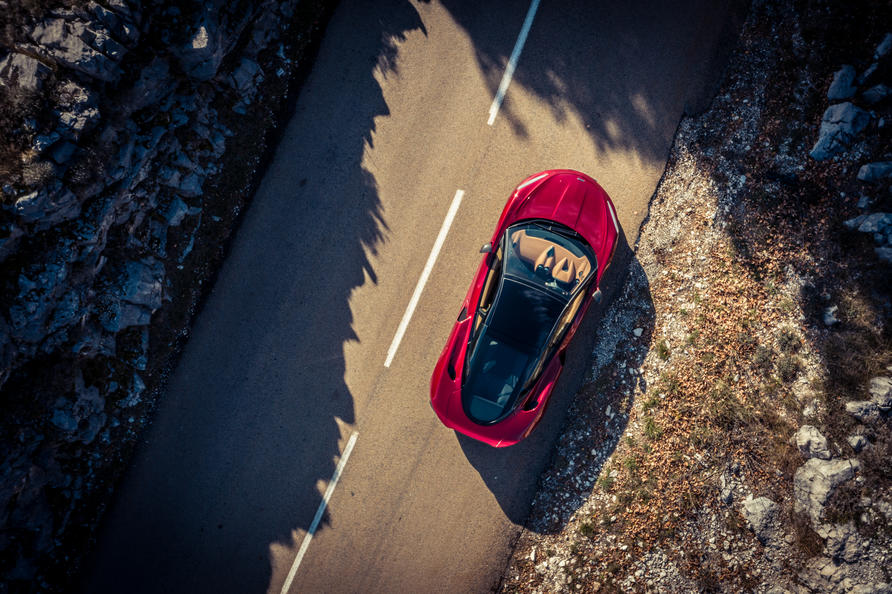
The Bentley is the opposite, and it’s easy to choose between them based on a simple calculus. What proportion of your driving is fantasy-recreational, and what proportion is on the sort of roads you don’t see in adverts (or magazine features)? If you’re on the former end of that sliding scale, get the McLaren, otherwise the Bentley. It’s the default posh coupe for a reason.
You’ll seldom see a Polestar. But that’s not because it’s wilfully oddball. It’s a clever, minimalist, discreet proposal that mildly subverts the conspicuous consumption of the grand GT class. It faces the future with creativity and bracing confidence.
It’s remarkable that such a diverse trio can do their job so well, even if it’s fair to say they each excel at different parts of that job. They’re just about the apogee for people like you and me, who always see a 1,000km destination as a roadtrip to relish, when everyone else sees only a flight-booking website.
Trending this week
- Car Review
BMW iX3





